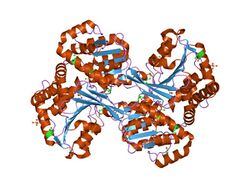Biology:Histidinol dehydrogenase
| Histidinol dehydrogenase | |||||||||
|---|---|---|---|---|---|---|---|---|---|
| Identifiers | |||||||||
| EC number | 1.1.1.23 | ||||||||
| CAS number | 9028-27-7 | ||||||||
| Databases | |||||||||
| IntEnz | IntEnz view | ||||||||
| BRENDA | BRENDA entry | ||||||||
| ExPASy | NiceZyme view | ||||||||
| KEGG | KEGG entry | ||||||||
| MetaCyc | metabolic pathway | ||||||||
| PRIAM | profile | ||||||||
| PDB structures | RCSB PDB PDBe PDBsum | ||||||||
| Gene Ontology | AmiGO / QuickGO | ||||||||
| |||||||||
| Histidinol dehydrogenase | |||||||||
|---|---|---|---|---|---|---|---|---|---|
 the l-histidinol dehydrogenase (hisd) structure implicates domain swapping and gene duplication. | |||||||||
| Identifiers | |||||||||
| Symbol | Histidinol_dh | ||||||||
| Pfam | PF00815 | ||||||||
| Pfam clan | CL0099 | ||||||||
| InterPro | IPR012131 | ||||||||
| PROSITE | PDOC00534 | ||||||||
| SCOP2 | 1k75 / SCOPe / SUPFAM | ||||||||
| |||||||||
In enzymology, histidinol dehydrogenase (HIS4) (HDH) (EC 1.1.1.23) is an enzyme that catalyzes the chemical reaction
- L-histidinol + 2 NAD+ L-histidine + 2 NADH + 2 H+
Thus, the two substrates of this enzyme are L-histidinol and NAD+, whereas its 3 products are L-histidine, NADH, and H+.
This enzyme belongs to the family of oxidoreductases, specifically those acting on the CH-OH group of donor with NAD+ or NADP+ as acceptor. The systematic name of this enzyme class is L-histidinol:NAD+ oxidoreductase. This enzyme is also called L-histidinol dehydrogenase.
Structure
In bacteria, HDH is a single chain polypeptide; in fungi it is the C-terminal domain of a multifunctional enzyme which catalyses three different steps of histidine biosynthesis; and in plants it is expressed as a nuclear encoded protein precursor which is exported to the chloroplast.[1][2][3]
Active site
Histidinol is held inside the active site thanks to a zinc ion, but the zinc ion does not participate in the catalysis otherwise. The zinc ion is held in place by His262, Gln259, Asp360 and His419 (which, in homodimeric histidinol dehydrogenases, comes from the other monomer). Histidinol itself is held in place by His327 and His367 from one moment unit and Glu414 from the other monomer unit.[3]
A Cys residue has been implicated in the catalytic mechanism of the second oxidative step.[4] However, according to newer studies with histidinol dehydrogenase from E. coli, the mechanism is catalyzed by four bases, B1-B4. His327 acts as the first base, deprotonating histidinol's hydroxyl group. Concomitantly, hydride is abstracted from histidinol by NAD+, which is then exchanged for a second NAD+ molecule. Glu325 acts as the second base, deprotonating a molecule of water, which then attacks histidinol. At the same time, His327 (now protonated) donates a proton to the aldehydic oxygen, which results in a gem-diol. After then, His327 again deprotonates one of the hydroxyl groups and NAD+ abstracts a proton from the reactive carbon atom. This series of steps oxidizes the hydroxyl group to a carboxylic acid.[3]
Function
Histidinol dehydrogenase catalyzes the terminal step in the biosynthesis of histidine in bacteria, fungi, and plants, the four-electron oxidation of L-histidinol to histidine.
In 4-electron dehydrogenases, a single active site catalyses 2 separate oxidation steps: oxidation of the substrate alcohol to an intermediate aldehyde; and oxidation of the aldehyde to the product acid, in this case His.[4] The reaction proceeds via a tightly- or covalently-bound intermediate, and requires the presence of 2 NAD molecules.[4] By contrast with most dehydrogenases, the substrate is bound before the NAD coenzyme.[4]
Co-regulation of the gene
Histodinol dehydrogenase gene (HIS4) has been shown co-regulating the adjacent gene while it is under amino acids selective pressure.[5]
Structural studies
As of late 2007, 4 structures have been solved for this class of enzymes, with PDB accession codes 1K75, 1KAE, 1KAH, and 1KAR.
References
- ↑ "Structural and functional conservation of histidinol dehydrogenase between plants and microbes". Proc. Natl. Acad. Sci. U.S.A. 88 (10): 4133–7. May 1991. doi:10.1073/pnas.88.10.4133. PMID 2034659. Bibcode: 1991PNAS...88.4133N.
- ↑ "Crystallization and preliminary crystallographic analysis of cabbage histidinol dehydrogenase". Acta Crystallogr. D 52 (Pt 6): 1188–90. November 1996. doi:10.1107/S0907444996008396. PMID 15299582. Bibcode: 1996AcCrD..52.1188C.
- ↑ 3.0 3.1 3.2 "Mechanism of action and NAD+-binding mode revealed by the crystal structure of L-histidinol dehydrogenase". Proc. Natl. Acad. Sci. U.S.A. 99 (4): 1859–64. February 2002. doi:10.1073/pnas.022476199. PMID 11842181. Bibcode: 2002PNAS...99.1859B.
- ↑ 4.0 4.1 4.2 4.3 "A cysteine residue (cysteine-116) in the histidinol binding site of histidinol dehydrogenase". Biochemistry 25 (17): 4778–84. August 1986. doi:10.1021/bi00365a009. PMID 3533140.
- ↑ "Increased expression and secretion of recombinant hIFNγ through amino acid starvation-induced selective pressure on the adjacent HIS4 gene in Pichia pastoris : Acta Facultatis Pharmaceuticae Universitatis Comenianae". http://www.degruyter.com/view/j/afpuc.2015.62.issue-2/afpuc-2015-0031/afpuc-2015-0031.xml.
Further reading
- Adams E (1954). "Enzymatic synthesis of histidine from histidinol". J. Biol. Chem. 209 (2): 829–846. doi:10.1016/S0021-9258(18)65512-7. PMID 13192138.
- Adams E (1955). "L-Histidinal, a biosynthetic precursor of histidine". J. Biol. Chem. 217 (1): 325–344. doi:10.1016/S0021-9258(19)57184-8. PMID 13271397.
- "Purification and crystallization of histidinol dehydrogenase from Salmonella typhimurium LT-2". J. Biol. Chem. 243 (12): 3273–6. 1968. doi:10.1016/S0021-9258(18)93303-X. PMID 4872177.
- Loper JC (1968). "Histidinol dehydrogenase from Salmonella typhimurium Crystallization and composition studies". J. Biol. Chem. 243 (12): 3264–72. doi:10.1016/S0021-9258(18)93302-8. PMID 4872176.
 |
